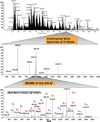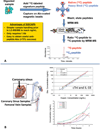Status and prospects for discovery and verification of new biomarkers of cardiovascular disease by proteomics
- PMID: 21817166
- PMCID: PMC3973157
- DOI: 10.1161/CIRCRESAHA.110.225003
Status and prospects for discovery and verification of new biomarkers of cardiovascular disease by proteomics
Abstract
Despite unmet needs for cardiovascular biomarkers, few new protein markers have been approved by the US Food and Drug Administration for the diagnosis or screening of cardiovascular diseases. Mass spectrometry-based proteomics technologies are capable of identifying hundreds to thousands of proteins in cells, tissues, and biofluids. Proteomics may therefore provide the opportunity to elucidate new biomarkers and pathways without a prior known association with cardiovascular disease; however, important obstacles remain. In this review, we focus on emerging techniques that may form a coherently integrated pipeline to overcome present limitations to both the discovery and validation processes.
Conflict of interest statement
Figures




Similar articles
-
Emerging Affinity-Based Proteomic Technologies for Large-Scale Plasma Profiling in Cardiovascular Disease.Circulation. 2017 Apr 25;135(17):1651-1664. doi: 10.1161/CIRCULATIONAHA.116.025446. Circulation. 2017. PMID: 28438806 Free PMC article. Review.
-
Qualification and Verification of Protein Biomarker Candidates.Adv Exp Med Biol. 2016;919:493-514. doi: 10.1007/978-3-319-41448-5_23. Adv Exp Med Biol. 2016. PMID: 27975232 Review.
-
Restructuring proteomics through verification.Biomark Med. 2010 Dec;4(6):799-803. doi: 10.2217/bmm.10.92. Biomark Med. 2010. PMID: 21133699 Free PMC article. Review.
-
Proteomic approach in the search of new cardiovascular biomarkers.Kidney Int Suppl. 2005 Dec;(99):S103-7. doi: 10.1111/j.1523-1755.2005.09919.x. Kidney Int Suppl. 2005. PMID: 16336560 Review.
-
Proteomics Research in Cardiovascular Medicine and Biomarker Discovery.J Am Coll Cardiol. 2016 Dec 27;68(25):2819-2830. doi: 10.1016/j.jacc.2016.10.031. J Am Coll Cardiol. 2016. PMID: 28007144 Free PMC article. Review.
Cited by
-
Metabolomics as a key integrator for "omic" advancement of personalized medicine and future therapies.Clin Transl Sci. 2012 Jun;5(3):285-8. doi: 10.1111/j.1752-8062.2011.00388.x. Clin Transl Sci. 2012. PMID: 22686208 Free PMC article. Review.
-
Systems-based approaches to cardiovascular disease.Nat Rev Cardiol. 2012 Jan 10;9(3):172-84. doi: 10.1038/nrcardio.2011.208. Nat Rev Cardiol. 2012. PMID: 22231714 Free PMC article. Review.
-
Matrix metalloproteinase (MMP)-9: a proximal biomarker for cardiac remodeling and a distal biomarker for inflammation.Pharmacol Ther. 2013 Jul;139(1):32-40. doi: 10.1016/j.pharmthera.2013.03.009. Epub 2013 Apr 3. Pharmacol Ther. 2013. PMID: 23562601 Free PMC article. Review.
-
Biomarkers intersect with the exposome.Biomarkers. 2012 Sep;17(6):483-9. doi: 10.3109/1354750X.2012.691553. Epub 2012 Jun 7. Biomarkers. 2012. PMID: 22672124 Free PMC article.
-
Biomarkers: hopes and challenges in the path from discovery to clinical practice.Transl Res. 2012 Apr;159(4):197-204. doi: 10.1016/j.trsl.2012.01.023. Epub 2012 Feb 14. Transl Res. 2012. PMID: 22424424 Free PMC article.
References
-
- Khot UN, Khot MB, Bajzer CT, Sapp SK, Ohman EM, Brener SJ, Ellis SG, Lincoff AM, Topol EJ. Prevalence of conventional risk factors in patients with coronary heart disease. JAMA. 2003;290:898–904. - PubMed
-
- Antman E, Grudzien C, Sacks DB. Evaluation of a rapid bedside assay for detection of serum cardiac troponin T. JAMA. 1995;273:1279–1282. - PubMed
-
- Lindahl B, Toss H, Siegbahn A, Venge P, Wallentin L for the FRISC Study Group. Fragmin during Instability in Coronary Artery Disease. Markers of myocardial damage and inflammation in relation to long-term mortality in unstable coronary artery disease. N Engl J Med. 2000;343:1139–1147. - PubMed
-
- Antman EM, Tanasijevic MJ, Thompson B, Schactman M, McCabe CH, Cannon CP, Fischer GA, Fung AY, Thompson C, Wybenga D, Braunwald E. Cardiac-specific troponin I levels to predict the risk of mortality in patients with acute coronary syndromes. N Engl J Med. 1996;335:1342–1349. - PubMed
-
- Hamm CW, Heeschen C, Goldmann B, Vahanian A, Adgey J, Miguel CM, Rutsch W, Berger J, Kootstra J, Simoons ML for the c7E3 Fab Antiplatelet Therapy in Unstable Refractory Angina (CAPTURE) Study Investigators. Benefit of abciximab in patients with refractory unstable angina in relation to serum troponin T levels. N. Engl. J. Med. 1999;340:1623–1629. - PubMed
Publication types
MeSH terms
Substances
Grants and funding
LinkOut - more resources
Full Text Sources

